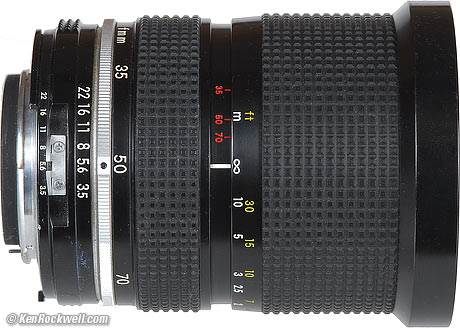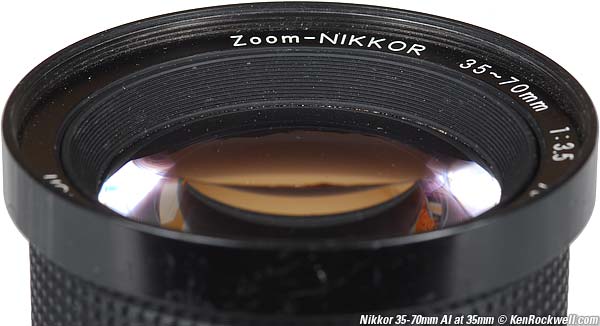Nikon
35-70mm f/3.5 AI
© 2007 KenRockwell.com
Nikon 35-70mm f/3.5 AI. enlarge. You my be able to find them used at Adorama. It helps me keep adding to this site when you get yours from these links, too.
December 2007 More Nikon Reviews
INTRODUCTION top
Intro Specifications Performance Recommendations
See my Nikon Professional Normal Zoom Comparison for exhaustive side-by-side image examples.
This 35-70mm f/3.5 AI was Nikon's first professional midrange zoom from 1977. It is very sharp at every setting and has a constant f/3.5 aperture. It has less distortion than any of Nikon's f/2.8 zooms, and that means much better than the 24-70mm AF-S and 28-70mm AF-S, each of which costs over ten times as much.
This 35-70mm f/3.5 works great on the Nikon D3, on which I tested it for this review.
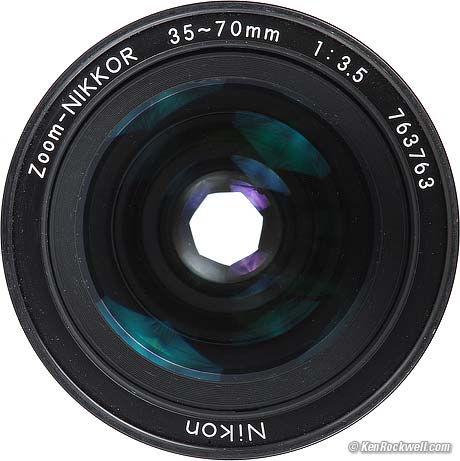
Nikon 35-70mm f/3.5 AI.
The 35-70mm f/3.5 AI is a masterpiece of precision. You have to feel one to appreciate it. The focus flips with a fingertip from 3 feet (1m) to infinity. All the zoom action happens inside the barrel: the front and rear groups move around inside the barrel while the exterior doesn't move at all.
NIkon made a 43-86mm f/3.5 zoom before this, but since it is neither a normal zoom (43-86mm is normal to tele), and since it was never pitched as a professional zoom, I'm not counting it as Nikon's first pro normal zoom. The 43-86mm was a convenience zoom, not a zoom with which to earn one's living.
Compatibility: On the D2, D3, D200, D300 and F6, use the "Non-CPU Lens Data" menu option to input the zoom setting and f/3.5, which will give you full matrix metering and EXIF data, and finder read-out of set aperture. It works great in aperture-preferred as well as manual modes on these cameras.
It couples to all the better AF and digital cameras.
It won't couple well to the cheaper digital (D80 and below) and cheaper film cameras (N80 and below). It works perfectly every professional film camera (F, F2, F3, F4, F5, F6), with Matrix metering on the FA, F4 and F6.
As a manual focus lens, the 35-70mm f/3.5 AI is ideal for use on any manual focus camera.
See Nikon Lens Compatibility for details on your camera. Read down the "AI, AI-s" column for this lens.
Production History: The 35-70mm f/3.5 AI was introduced in 1977 and built until it was replaced by the 35-70mm f/3.5 AI-s in 1981. Nikon made about 50,000 of these AI versions.
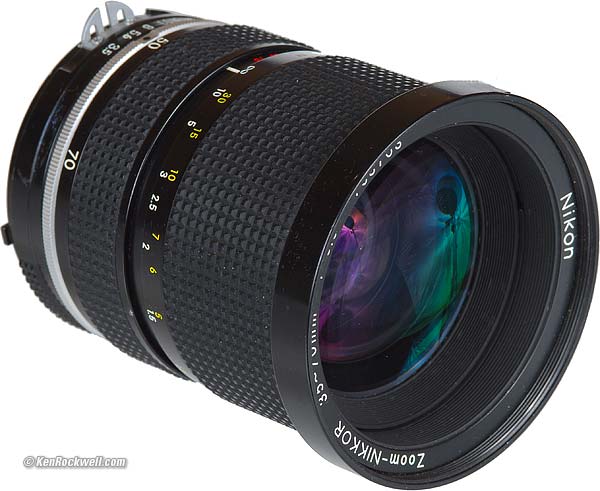
Nikon 35-70mm f/3.5 AI.
SPECIFICATIONS top
Intro Specifications Performance Recommendations
Name: Nikon calls this the Nikon Zoom-NIKKOR 35~70mm f/3.5 AI.
Optics: 10 elements in 9 groups. Traditional spherical design, multicoated. Traditional front-group focusing.
Diaphragm: Seven traditional straight blades. Stops down to f/22.
Close Focus: 3.3 feet (1m). No macro modes.
Infra-Red Focus Indices: Yes, at 35, 50 and 70mm.
Depth-of-Field Scale: None.
Filter Size: 72mm.
Focal Length: 35-70mm. Used on a DX camera it gives angles of view similar to what a 50-105mm lens would give on an FX or 35mm film camera. See also Crop Factor.
Maximum Aperture: f/3.5 at all focal lengths.
Size: 3.644" extension from flange by 2.951" diameter (92.55 x 74.97mm), as measured by me.
Weight: 19.000 oz (538.6 g), as measured by me.
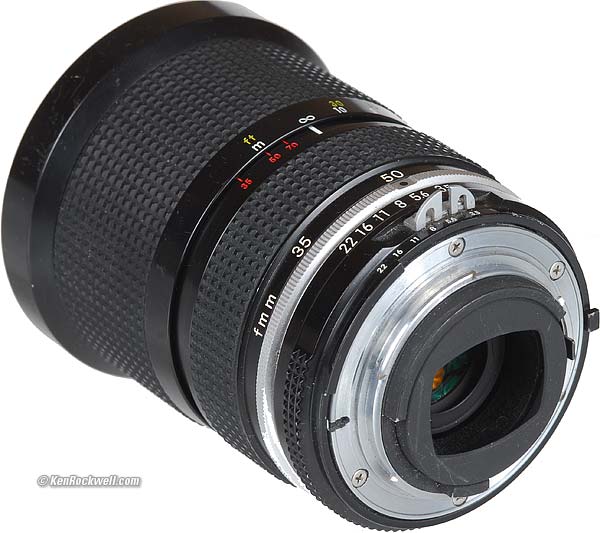
Nikon 35-70mm f/3.5 AI.
PERFORMANCE top
Intro Specifications Performance Recommendations
Overall
See my Nikon Professional Normal Zoom Comparison for exhaustive side-by-side image examples.
This lens is a joy to use. It just works, never gets in the way, and yields great results. Just be careful not to let the sun shine into it for fear of veiling flare.
As a two-ring zoom it's best for use on a tripod. Hand-held, I constantly need to grab zoom, then focus, then zoom, then focus, etc. I can't do both at once as I can with a one-touch zoom.
Distortion top
Distortion is lower than any Nikon f/2.8 zoom, ha ha.
It has some very minor barrel distortion at 35mm, which goes away at 50 and 70mm.
Plug these figures into Photoshop CS2's lens distortion filter to correct the distortion. These aren't facts or specifications, they are the results of my research that requires me to climb a bluff on a very clear day and shoot the ocean's horizon.
at infinity: |
FX and Film |
|
35mm |
+1.3 |
+1.0 |
50mm |
0.0 |
0.0 |
70mm |
-0.2 |
0.0 |
© 2007 KenRockwell.com
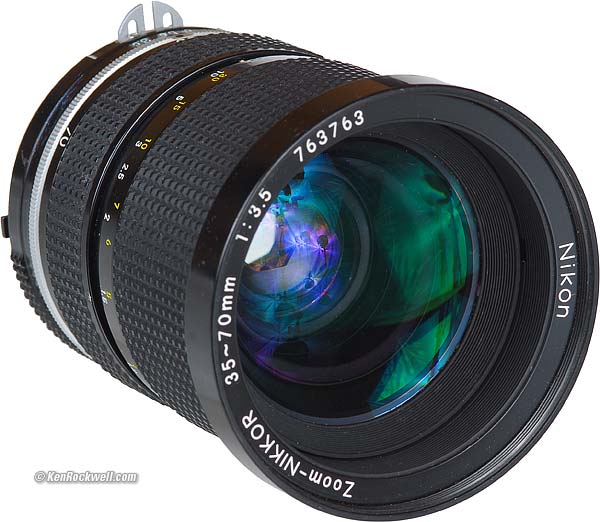
Nikon 35-70mm f/3.5 AI.
Sharpness (On Full-Frame Nikon D3) top
Sharpness is excellent.
Center
On a Nikon D3, it's perfectly sharp in the center at f/3.5 at 35 and 50mm. At 70m, stop down to f/5.6 and it's perfectly sharp. It's only a little softer at f/3.5.
Corners
35mm: A little softer at f/3.5, better at f/5.6, perfect at f/8.
50mm: A little softer at f/3.5, better at f/5.6, perfect at f/8.
70mm: Softer at f/3.5, much better at f/5.6, perfect at f/8.
Lateral Color Fringes top
None, as tested on a Nikon D3 or D200.
Flare top
Keep the sun out of it. If the sun hits my glass there is an overall veiling effect.
Ghosts aren't s a problem compared to overall veiling flare.
Zooming top
Roll your mouse over to see it zoom from 35 to 70mm.
The Nikon 35-70mm f/3.5 AI zooms by moving the elements inside the barrel. Nothing moves externally except the zoom ring. Roll your mouse over to see what happens. I moved the focus a little between shots; pay attention not to the focus ring but to the glass which is moving up and down.
This makes it very sturdy because a knock to the front of the lens is not a direct knock to the optics, as it is on the f/2.8 zooms. Keep a filter on the front, and if you bang it, you're not likely to upset the delicate zoom cams.
It holds focus while zoomed. Of course if you focus at 35mm you don't have enough precision to ensure focus at 70mm. Focus at 70mm and the focus holds as you zoom wider.
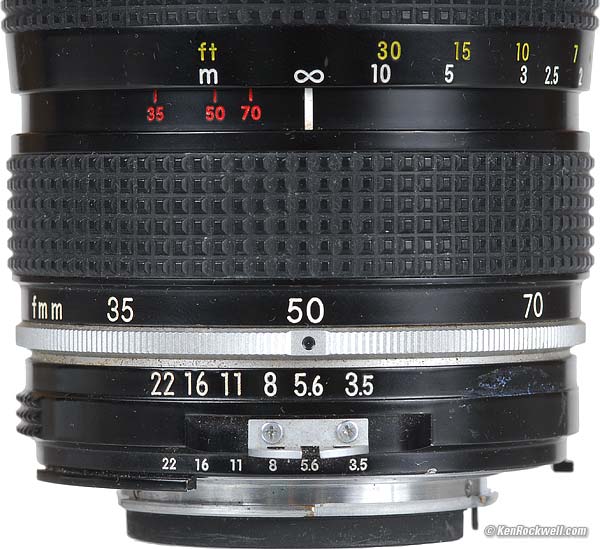
Nikon 35-70mm f/3.5 AI.
RECOMMENDATIONS top
Intro Specifications Performance Recommendations
The 35-70mm f/3.5 AI is a great lens for film and FX Digital. It's silly for DX digital because there are far more modern DX lenses that do a much more convenient job.
See one and want one? Get it. They rarely sell for more than $100 used. This was a very expensive lens in its day and it will not disappoint.
If you can take your time, the newer 35-70mm f/3.5 AI-s lens is even better optically, although I find this AI version easier to focus.
PLUG
If you find this as helpful as a book you might have had to buy or a workshop you may have had to take, feel free to help me continue helping everyone.
Thanks for reading!
Ken
Caveat: The all the ads below come from third parties. I don't see them before they appear on your screen. See more at my Buying Advice page. Personally I get my goodies at Ritz (the store, not the hotel gift shop), Amazon and Adorama.




